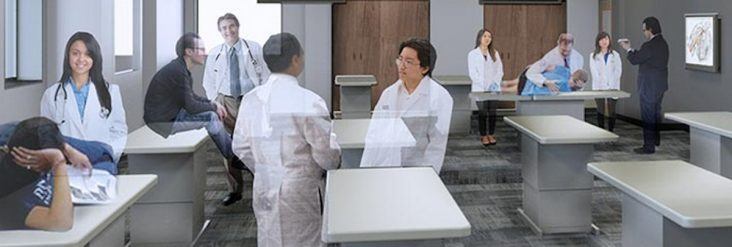Osteopathic program at ASU readies for first class, working with area hospitals
by April 28, 2016 4:22 pm 375 views

Dr. Barbara Ross-Lee said Thursday (April 28) that an osteopathy school at Arkansas State University slated to open later this year will meet a growing need for doctors in the state as well as providing training in the medical field.
Ross-Lee, the dean for the NYITCOM Osteopathy School, said a ribbon cutting for the school will be June 2, with classes beginning Aug. 8. The first set of students to graduate will be in May 2020, with the students taking up residency in July 2020. New York Institute of Technology received in December the final approval to open the campus at Wilson Hall.
Since then, a $12.6 million renovation of Wilson Hall – one of the oldest buildings at the Jonesboro campus that formerly housed the political science department – has made space for the school. Crews have installed labs and signage throughout the building.
“Wilson Hall looks nice, absolutely gorgeous,” Ross-Lee said of the building.
Ross-Lee said 115 students will begin in August with another 150 students on a waiting list. About half of the students this fall are from Arkansas, with the rest from Alabama, Missouri, Mississippi and Tennessee. The goal is to have the students educated in Arkansas as well as working in the state.
ASU officials began working with NYIT in 2012 on the medical school project, Talk Business and Politics previously reported. At least 80 people will be hired for the school while officials said last year that a 2014 study from Tripp Umbach showed the school would provide a $70 million boost to the regional economy.
Officials are also working to hire doctors and staff to work at the school, which is one of two set in the state (with a school in Fort Smith being the other). Talk Business and Politics reported last year that the Arkansas College of Osteopathic Medicine would move into a $31 million facility with nearly 600 students and 65 employees.
The need for doctors is critical, Ross-Lee said.
“The shortage of doctors is bad in Arkansas,” Ross-Lee said, noting it can take between four and seven years for medical students to go through school and residency at a hospital.
Hospitals and clinics are constantly trying to recruit doctors. Ross-Lee said she has spoken to at least 24 hospitals in the region about creating a doctor education program to help medical students learn more. St. Bernards Healthcare is working on a plan to create an internal medicine residency program, hospital officials announced earlier this month. NEA Baptist and Arkansas Methodist Medical Center in Paragould are working on applications for residency training with the school. Ross-Lee said the program has received a lot of support from ASU as well as residents in Jonesboro.
The curriculum for the medical school is complex and varied, Ross-Lee said. The curriculum for an osteopathy school teaches students about different systems of the body, including cardiac and gastrointestinal. Students also learn to use their hands to help diagnose problems as well as looking at muscular/skeletal areas for signs.
The first two years teach students how to handle emergency situations as well as ways to interview patients, while the last two years are taught in a hospital setting with future doctors learning their discipline, Ross-Lee said.
